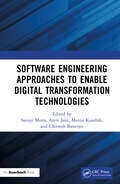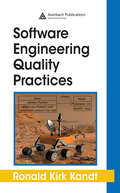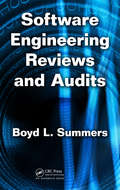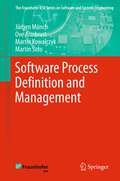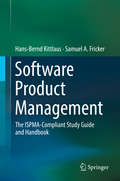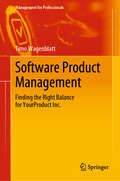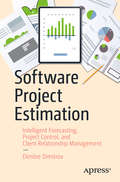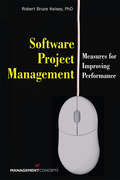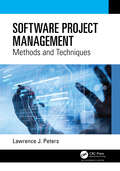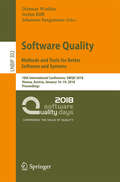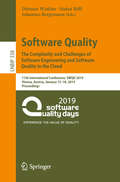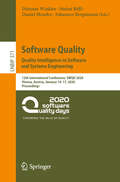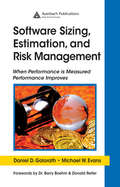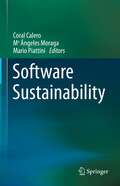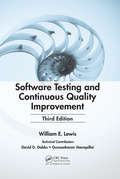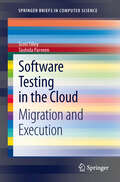- Table View
- List View
Software Engineering Approaches to Enable Digital Transformation Technologies
by Amit Jain Sanjay Misra Chitresh Banerjee Manju KaushikSoftware Engineering Approaches to Enable Digital Transformation Technologies features contributions reflecting ideas and research in enabling digital transformation technologies through software engineering. To date, multiple, different approaches have been adopted to develop software solutions for a variety of different problems. Of all the available approaches, the main approaches are level-oriented, data flow-oriented, data structure-oriented, and object-oriented design approaches. The other focus of the book is digital transformation, which can be defined as the adoption of digital technology to improve efficiency, value, and innovation Digitalization is more than just putting additional technological systems and services in place. Rather than improving conventional methods, a true digital transformation initiative includes radically rethinking company structures and procedures. There are four types of digital transformation: business process, business model, domain, and cultural and organizational. Companies are being challenged to develop new business models that consider and harness digitalization. From the standpoint of software engineering, digital transformation alters how software is built. Current trends include the development of mobile applications, cloud applications, and Internet of Things (IoT) applications. Emerging trends are the development of digital twins, robotics, artificial intelligence, machine learning, augmented reality, and additive manufacturing. This book examines the challenges that arise due to digitization in society and presents plausible solutions that could be applied to counter these challenges and convert them into opportunities. These solutions may further be improvised and worked out for the software companies from the technological perspective, organizational perspective, and management perspective.
Software Engineering Frameworks for the Cloud Computing Paradigm
by Zaigham Mahmood Saqib SaeedThis book presents the latest research on Software Engineering Frameworks for the Cloud Computing Paradigm, drawn from an international selection of researchers and practitioners. The book offers both a discussion of relevant software engineering approaches and practical guidance on enterprise-wide software deployment in the cloud environment, together with real-world case studies. Features: presents the state of the art in software engineering approaches for developing cloud-suitable applications; discusses the impact of the cloud computing paradigm on software engineering; offers guidance and best practices for students and practitioners; examines the stages of the software development lifecycle, with a focus on the requirements engineering and testing of cloud-based applications; reviews the efficiency and performance of cloud-based applications; explores feature-driven and cloud-aided software design; provides relevant theoretical frameworks, practical approaches and future research directions.
Software Engineering Quality Practices (Applied Software Engineering Series)
by Ronald Kirk KandtLearn how to attract and keep successful software professionals Software Engineering Quality Practices describes how software engineers and the managers that supervise them can develop quality software in an effective, efficient, and professional manner. This volume conveys practical advice quickly and clearly while avoiding the dogma that surr
Software Engineering Reviews and Audits
by Boyd L. SummersAccurate software engineering reviews and audits have become essential to the success of software companies and military and aerospace programs. These reviews and audits define the framework and specific requirements for verifying software development efforts.Authored by an industry professional with three decades of experience, Software Engineerin
Software Engineering and Methodology for Emerging Domains: 16th National Conference, NASAC 2017, Harbin, China, November 4–5, 2017, and 17th National Conference, NASAC 2018, Shenzhen, China, November 23–25, 2018, Revised Selected Papers (Communications in Computer and Information Science #861)
by Ming Li Zheng Li Minghui Zhou He Jiang Ge LiThis book constitutes the thoroughly refereed proceedings of the 16th National Conference, NASAC 2017, held in Harbin, China, in November 2017, and the 17th National Conference, NASAC 2018, held in Shenzhen, China, in November 2018. The 6 revised selected papers were selected from 17 submissions for NASAC 2017, and 5 revised selected papers were selected from 20 submissions for NASAC 2018. The papers focus on all aspects of software engineering, e.g. requirements engineering, software methodologies, software analytics, software testing and evolution, and empirical studies.
Software Estimation Without Guessing: Effective Planning in an Imperfect World
by George DinwiddieEstimating software development often produces more angst than value, but it doesn't have to. Identify the needs behind estimate requests and determine how to meet those needs simply and easily. Choose estimation techniques based on current needs and available information, gaining benefit while reducing cost and effort. Detect bad assumptions that might sink your project if you don't adjust your plans. Discover what to do when an estimate is wrong, how to recover, and how to use that knowledge for future planning. Learn to communicate about estimates in a healthy and productive way, maximizing advantage to the organization and minimizing damage to the people. In a world where most developers hate estimation and most managers fear disappointment with the results, there is hope for both. It requires giving up some widely held misconceptions. Let go of the notion that "an estimate is an estimate" and estimate for the particular need you, and your organization, have. Realize that estimates have a limited shelf-life, and reestimate frequently if it's important. When reality differs from your estimate, don't lament; mine that disappointment for the gold that can be the longer-term jackpot. Estimate in comparison to past experience, by modeling the work mathematically, or a hybrid of both. Learn strategies for effective decomposition of work and aspects of the work that likely affect your estimates. Hedge your bets by comparing the results of different approaches. Find out what to do when an estimate proves wrong. And they will. They're estimates, after all. You'll discover that you can use estimates to warn you of danger so you can take appropriate action in time. Learn some crucial techniques to understand and communicate with those who need to understand. Address both the technical and sociological aspects of estimation, and you'll help your organization achieve its desired goals with less drama and more benefit. What You Need: No software needed, just your past experience and concern for the outcomes.
Software Extension to the PMBOK Guide
by Project Management InstituteDesigned to be used in tandem with the latest edition of the PMBOK Guide, this comprehensive volume closely follows the PMBOK Guide's approach to style, structure and naming, while providing readers a balanced view of methods, tools, and techniques for managing software projects across the life cycle continuum from highly predictive life cycles to highly adaptive life cycles. Software Extension to the PMBOK Guide Fifth Edition provides readers with knowledge and practices that will not only improve their efficiency and effectiveness but that of their management teams and project members as well.
Software Process Definition and Management
by Martin Kowalczyk Jürgen Münch Martín Soto Ove ArmbrustThe concept of processes is at the heart of software and systems engineering. Software process models integrate software engineering methods and techniques and are the basis for managing large-scale software and IT projects. High product quality routinely results from high process quality. Software process management deals with getting and maintaining control over processes and their evolution. Becoming acquainted with existing software process models is not enough, though. It is important to understand how to select, define, manage, deploy, evaluate, and systematically evolve software process models so that they suitably address the problems, applications, and environments to which they are applied. Providing basic knowledge for these important tasks is the main goal of this textbook. Münch and his co-authors aim at providing knowledge that enables readers to develop useful process models that are suitable for their own purposes. They start with the basic concepts. Subsequently, existing representative process models are introduced, followed by a description of how to create individual models and the necessary means for doing so (i.e., notations and tools). Lastly, different possible usage scenarios for process management are highlighted (e.g. process improvement and software process simulation). Their book is aimed at students and researchers working on software project management, software quality assurance, and software measurement; and at practitioners who are interested in process definition and management for developing, maintaining, and operating software-intensive systems and services.
Software Process Improvement and Capability Determination: 18th International Conference, SPICE 2018, Thessaloniki, Greece, October 9–10, 2018, Proceedings (Communications in Computer and Information Science #918)
by Ioannis Stamelos Rory V. O'Connor Terry Rout Alec DorlingThis volume constitutes the refereed proceedings of the 18th International Conference on Software Process Improvement and Capability Determination, SPICE 2018, held in Tessaloniki, Greece, in October 2018. The 26 full papers presented were carefully reviewed and selected from 40 submissions. The papers are organized in the following topical sections: SPI systematic literature reviews; SPI and assessment; SPI methods and reference models; SPI education and management issues; SPI knowledge and change processes; SPI compliance and configuration; SPI and agile; industry short papers.
Software Product Management
by Samuel A. Fricker Hans-Bernd KittlausThis book gives a comprehensive overview on Software Product Management (SPM) for beginners as well as best practices, methodology and in-depth discussions for experienced product managers. This includes product strategy, product planning, participation in strategic management activities and orchestration of the functional units of the company. The book is based on the results of the International Software Product Management Association (ISPMA) which is a group of SPM experts from industry and research with the goal to foster software product management excellence across industries. ISPMA is focused on establishing software product management as a discipline of its own in both academia and industry. It disseminates and maintains a curriculum and a certifiable body of knowledge (SPMBoK). This book can be used as textbook for ISPMA-based education and as guide for anybody interested in SPM as one of the most exciting disciplines in the business of software.
Software Product Management: Finding the Right Balance for YourProduct Inc. (Management for Professionals)
by Timo WagenblattThis book is for product managers, product owners, product marketing managers, VPs and Heads of Product, CEOs, and start-up founders. In short, it serves anyone interested personally or professionally in software product management. You’ll learn how to plan, coordinate and execute all activities required for software product success. It enables you to find the right balance for delivering customer value and long-term product success.The book offers a comprehensive introduction for beginners as well as proven practices and a novel, holistic approach for experienced product managers. It provides much-needed clarity regarding the numerous tasks and responsibilities involved in the professional and successful management of software products. Readers can use this book as a reference book if they are interested in or have the urgent need to improve one of the following software product management dimensions: Product Viability, Product Development, Go-to-Market / Product Marketing, Software Demonstrations and Training, The Market / Your Customers, or Organizational Maturity.The book helps product people to maximize their impact and effectiveness. Whether you’re a seasoned practitioner, new to software product management, or just want to learn more about the best-of-all disciplines and advance your skills, this book introduces a novel and “business” tested approach to structure and orchestrate the vital dimensions of software product management. You will learn how to create focus and alignment on the things that matter for product success.The book describes a holistic framework to keep the details that matter for product success in balance, taking into consideration the limiting factors, strategies and responsibilities that determine the overall product yield potential. It explains how to leverage and adapt the framework with regard to aspects like product viability, product development, product marketing and software demonstrations and training, as well as more general aspects like markets, customers and organizational maturity.The book focuses on the unique challenges of software product managers or any related roles, whether you are a founder of a small to mid-sized software company or working in the complex ecosystems of large software enterprises or corporate IT departments.
Software Product Quality Control
by Stefan WagnerQuality is not a fixed or universal property of software; it depends on the context and goals of its stakeholders. Hence, when you want to develop a high-quality software system, the first step must be a clear and precise specification of quality. Yet even if you get it right and complete, you can be sure that it will become invalid over time. So the only solution is continuous quality control: the steady and explicit evaluation of a product's properties with respect to its updated quality goals. This book guides you in setting up and running continuous quality control in your environment. Starting with a general introduction on the notion of quality, it elaborates what the differences between process and product quality are and provides definitions for quality-related terms often used without the required level of precision. On this basis, the work then discusses quality models as the foundation of quality control, explaining how to plan desired product qualities and how to ensure they are delivered throughout the entire lifecycle. Next it presents the main concepts and techniques of continuous quality control, discussing the quality control loop and its main techniques such as reviews or testing. In addition to sample scenarios in all chapters, the book is rounded out by a dedicated chapter highlighting several applications of different subsets of the presented quality control techniques in an industrial setting. The book is primarily intended for practitioners working in software engineering or quality assurance, who will benefit by learning how to improve their current processes, how to plan for quality, and how to apply state-of-the-art quality control techniques. Students and lecturers in computer science and specializing in software engineering will also profit from this book, which they can use in practice-oriented courses on software quality, software maintenance and quality assurance.
Software Project Estimation: Intelligent Forecasting, Project Control, and Client Relationship Management
by Dimitre DimitrovIn Software Project Estimation, author Dimitre Dimitrov extrapolates upon the most crucial steps in accurately and meaningfully forecasting the timeline and specs of promised deliverables to clients. A client’s positive experience with project delivery and implementation is a software organization’s calling card in the industry. The lifespan of a software project—from ideation to final installation—introduces dozens of potential pitfalls for a company’s track record, earnings, and overall team morale. However, these “pitfalls” are also opportunities to showcase strengths and to improve an organization’s product quality, and it all starts with project estimation.Reliable forecasting continues to present a challenge to even the most veteran teams and software development organizations. Dimitrov sets out to ease these common difficulties with invaluable methodology improvements and helpful visuals from his years of industry experience. Project managers—through harnessing the power of hard data and statistics—have a new world of impactful forecasting at their fingertips. This approach brings security, predictability, and motivation within the team, while simultaneously greatly benefiting client trust and relationships. Software Project Estimation clarifies the common misunderstandings that materialize between making a promise, making a plan, and building a forecast backed by data. Learn how to create an intelligent software project forecast and use it to make timely decisions, apply measured project control, and confidently steer your ship toward your goals with Software Project Estimation. What You Will Learn Concepts related to software estimation, forecasting, and project controlWays in which you can positively affect the relationships among team members working on a software delivery projectHow to apply this forecasting model, within both agile and waterfall teams who have adopted sound engineering practices Who This Book is ForThis book is directly relevant to the roles of scrum masters and project managers, and provides practical tools for intelligent project control. The book is also valuable for business people who want insight into the type of problems that delivery teams face, and for programmers and other delivery team members who want to gain an understanding of the project manager’s day-to-day challenges.
Software Project Management: Measures for Improving Performance (Management Concepts)
by Robert Bruce KelseySoftware Project Management: Measures for Improving Performance focuses on more than the mechanics of project execution. By showing the reader how to identify and solve real world problems that put schedule, cost, and quality at risk, this guide gets to the heart of improving project control and performance.• Identify measurement needs and goals• Determine what measures to use to maximize the value of data• Interpret data and report the results• Diagnose quality and productivity issues• Use metrics data to solve real problemsThis is a must-read for project managers and engineering managers working in organizations where deadlines are tight, the workload is daunting, and daily crises are the rule rather than the exception. The text provides simple run rate data through progressively advanced measures, as well as:• Examples that show you how to combine measures to solve complex problems• Exercises that guide you through best practices for metric program development and implementationFrom beginning to end, Software Project Management: Measures for Improving Performance guides you to improved project performance — long before you turn the last page!
Software Project Management: Methods and Techniques
by Lawrence J. PetersThe management of a software project has been shown to be the number one factor in determining a software development project’s success. It has been found that most software projects fail because of poor management. Not surprisingly, most software development managers have not been trained in project management. Software Project Management: Methods and Techniques aims to remedy this situation in two ways: familiarizing software developers with the elements of the project management discipline and providing fact-based resources on practicing software project management.Much like the checklist pilots go through prior to a flight, this book provides a pre-project checklist which enables the software engineering team to review and evaluate an extensive set of technical and sociopolitical risks which will help the software project manager and the team determine the project team’s chances of success. This same list and the individual question responses can be used later as part of the project’s closeout process helping team members to improve their individual and collective abilities to assess risk.Intended for both students and software project managers, the book is organized along the lines of the five major functions of a software project manager: planning; scheduling and costing; controlling; staffing; and motivating. The basics of each of these functions are presented in a single chapter. These are followed by a series of narrow topic presentations in the form of appendices that are intended to help solve specific problems that may occur during the conduct of a software project. As in the main portion of the text, the appendices include references that provide an avenue into further detail on the topic. Designed to promote project success, this approach has been taken because software projects are each unique undertakings such that providing a "one size fits all" approach will fail most of the time.
Software Quality. Complexity and Challenges of Software Engineering in Emerging Technologies: 9th International Conference, SWQD 2017, Vienna, Austria, January 17-20, 2017, Proceedings (Lecture Notes in Business Information Processing #269)
by Dietmar Winkler, Stefan Biffl and Johannes BergsmannThis book constitutes the refereed proceedings of the 9th Software Quality Days Conference, SWQD 2017, held in Vienna, Austria, in January 2017. The SWQD conference offers a range of comprehensive and valuable information by presenting new ideas from the latest research papers, keynote speeches by renowned academics and industry leaders, professional lectures, exhibits, and tutorials. The 4 full papers and 7 short papers presented in this volume were carefully reviewed and selected from 21 submissions. They were organized in topical sections named: model-driven development and configuration management; software development and quality assurance; software quality assurance in industry; crowdsourcing in software engineering; software testing and traceability; and process improvement. The book also contains one keynote talk in full paper length.
Software Quality: 10th International Conference, SWQD 2018, Vienna, Austria, January 16–19, 2018, Proceedings (Lecture Notes in Business Information Processing #302)
by Dietmar Winkler, Stefan Biffl and Johannes BergsmannThis book constitutes the refereed proceedings of the 10th Software Quality Days Conference, SWQD 2018, held in Vienna, Austria, in January 2018. The Software Quality Days (SWQD) conference started in 2009 and has grown to the biggest conferences on software quality in Europe with a strong community. The program of the SWQD conference is designed to encompass a stimulating mixture of practical presentations and new research topics in scientific presentations. The guiding conference topic of the SWQD 2018 is “Software Quality 4.0: Methods and Tools for better Software and Systems”, as novel technologies include new challenges and might require new and adapted methods and tools to support quality assurance activities early. The 6 full papers and 2 short papers presented in this volume were carefully reviewed and selected from 16 submissions. The volume also contains 2 invited talks. The contributions were organized in topical sections named: safety and security; requirements engineering and requirements-based testing; crowdsourcing in software engineering; software and systems architecture; experimentation in software engineering; and smart environments.
Software Quality: 11th International Conference, SWQD 2019, Vienna, Austria, January 15–18, 2019, Proceedings (Lecture Notes in Business Information Processing #338)
by Dietmar Winkler Stefan Biffl Johannes BergsmannThis book constitutes the refereed proceedings of the 11th Software Quality Days Conference, SWQD 2019, held in Vienna, Austria, in January 2019. The Software Quality Days (SWQD) conference started in 2009 and has grown to the biggest conference on software quality in Europe with a strong community. The program of the SWQD conference is designed to encompass a stimulating mixture of practical presentations and new research topics in scientific presentations. The guiding conference topic of the SWQD 2019 is “The Complexity and Challenges of Software Engineering and Software Quality in the Cloud”. The 5 full papers and 3 short papers presented in this volume were carefully reviewed and selected from 17 submissions. The volume also contains 2 invited talks. The contributions were organized in topical sections named: multi-disciplinary systems and software engineering; software quality and process improvement; software testing; knowledge engineering and machine learning; source code analysis; and software maintenance.
Software Quality: 12th International Conference, SWQD 2020, Vienna, Austria, January 14–17, 2020, Proceedings (Lecture Notes in Business Information Processing #371)
by Daniel Mendez Dietmar Winkler Stefan Biffl Johannes BergsmannThis book constitutes the refereed proceedings of the 12th Software Quality Days Conference, SWQD 2020, held in Vienna, Austria, in January 2020.The Software Quality Days (SWQD) conference started in 2009 and has grown to the biggest conference on software quality in Europe with a strong community. The program of the SWQD conference is designed to encompass a stimulating mixture of practical presentations and new research topics in scientific presentations. The guiding conference topic of the SWQD 2020 is “Quality Intelligence in Software and Systems Engineering”. The 5 full papers and 2 short papers presented in this volume were carefully reviewed and selected from 17 submissions. The volume also contains 2 invited talks. The contributions were organized in topical sections named: industry challenges and collaborations; software testing approaches; social aspects in software engineering; natural language processing; and software quality assurance concepts.
Software Quality: 13th International Conference, SWQD 2021, Vienna, Austria, January 19–21, 2021, Proceedings (Lecture Notes in Business Information Processing #404)
by Daniel Mendez Dietmar Winkler Stefan Biffl Johannes Bergsmann Manuel WimmerThis book constitutes the refereed proceedings of the 13th Software Quality Days Conference, SWQD 2021, which was planned to be held in Vienna, Austria, during January 19–21, 2021. Due to the COVID-19 pandemic, the conference was cancelled and will be merged with SWQD 2022. The Software Quality Days (SWQD) conference started in 2009 and has grown to the biggest conference on software quality in Europe with a strong community. The program of the SWQD conference is designed to encompass a stimulating mixture of practical presentations and new research topics in scientific presentations. The guiding conference topic of the SWQD 2021 is “Future Perspectives on Software Engineering Quality”. The 3 full papers and 5 short papers presented in this volume were carefully reviewed and selected from 13 submissions. The volume also contains 2 invited talks and one introductory paper for an interactive session. The contributions were organized in topical sections named: automation in software engineering; quality assurance for AI-based systems; machine learning applications; industry-academia collaboration; and experimentation in software engineering.
Software Rights: How Patent Law Transformed Software Development in America
by Gerardo Con DiazA new perspective on United States software development, seen through the patent battles that shaped our technological landscape This first comprehensive history of software patenting explores how patent law made software development the powerful industry that it is today. Historian Gerardo Con Díaz reveals how patent law has transformed the ways computing firms make, own, and profit from software. He shows that securing patent protection for computer programs has been a central concern among computer developers since the 1950s and traces how patents and copyrights became inseparable from software development in the Internet age. Software patents, he argues, facilitated the emergence of software as a product and a technology, enabled firms to challenge each other’s place in the computing industry, and expanded the range of creations for which American intellectual property law provides protection. Powerful market forces, aggressive litigation strategies, and new cultures of computing usage and development transformed software into one of the most controversial technologies ever to encounter the American patent system.
Software Sizing, Estimation, and Risk Management: When Performance is Measured Performance Improves
by Daniel D. Galorath Michael W. EvansTo achieve consistent software project success under the pressures of today's software development environment, software organizations require achievable plans including viable estimates of schedule, resources, and risks. To estimate realistically, you must understand how to apply sound estimation processes, tools, and data. Software Sizing
Software Sustainability
by Coral Calero Mario Piattini Mª Ángeles MoragaThis book focuses on software sustainability, regarded in terms of how software is or can be developed while taking into consideration environmental, social, and economic dimensions. The sixteen chapters cover various related issues ranging from technical aspects like energy-efficient programming techniques, formal proposals related to energy efficiency measurement, patterns to build energy-efficient software, the role of developers on energy efficient software systems and tools for detecting and refactoring code smells/energy bugs; to human aspects like its impact on software sustainability or the adaptation of ACM/IEEE guidelines for student and professional education and; and an economics-driven architectural evaluation for sustainability. Also aspects as the elements of governance and management that organizations should consider when implementing, assessing and improving Green IT or the relationship between software sustainability and the Corporate Social Responsibility of software companies are included. The chapters are complemented by usage scenarios and experience reports on several domains as cloud applications, agile development or e-Health, among others. As a whole, the chapters provide a complete overview of the various issues related to sustainable software development. The target readership for this book includes CxOs, (e.g. Chief Information Officers, Chief Executive Officers, Chief Technology Officers, etc.) software developers, software managers, auditors, business owners, and quality professionals. It is also intended for students of software engineering and information systems, and software researchers who want to know the state of the art regarding software sustainability.
Software Testing and Continuous Quality Improvement
by William E. LewisIt is often assumed that software testing is based on clearly defined requirements and software development standards. However, testing is typically performed against changing, and sometimes inaccurate, requirements. The third edition of a bestseller, Software Testing and Continuous Quality Improvement, Third Edition provides a continuous quality framework for the software testing process within traditionally structured and unstructured environments. This framework aids in creating meaningful test cases for systems with evolving requirements. This completely revised reference provides a comprehensive look at software testing as part of the project management process, emphasizing testing and quality goals early on in development. Building on the success of previous editions, the text explains testing in a Service Orientated Architecture (SOA) environment, the building blocks of a Testing Center of Excellence (COE), and how to test in an agile development. Fully updated, the sections on test effort estimation provide greater emphasis on testing metrics. The book also examines all aspects of functional testing and looks at the relation between changing business strategies and changes to applications in development. Includes New Chapters on Process, Application, and Organizational Metrics All IT organizations face software testing issues, but most are unprepared to manage them. Software Testing and Continuous Quality Improvement, Third Edition is enhanced with an up-to-date listing of free software tools and a question-and-answer checklist for choosing the best tools for your organization. It equips you with everything you need to effectively address testing issues in the most beneficial way for your business.
Software Testing in the Cloud: Migration and Execution
by Tauhida Parveen Scott TilleyFor a large, complex system, the amount of test cases in a regression test suite can range from a few hundred to several thousands, which can take hours or even days to execute. Regression testing also requires considerable resources that are often not readily available. This precludes their use in an interactive setting, further contributing to an inefficient testing process. Cloud computing offers the use of virtualized hardware, effectively unlimited storage, and software services that can help reduce the execution time of large test suites in a cost-effective manner. The research presented by Tilley and Parveen leverages the resources provided by cloud computing infrastructure to facilitate the concurrent execution of test cases. They introduce a decision framework called SMART-T to support migration of software testing to the cloud, a distributed environment called HadoopUnit for the concurrent execution of test cases in the cloud, and a series of case studies illustrating the use of the framework and the environment. Experimental results indicate a significant reduction in test execution time is possible when compared with a typical sequential environment. Software testing in the cloud is a subject of high interest for advanced practitioners and academic researchers alike. For advanced practitioners, the issue of cloud computing and its impact on the field of software testing is becoming increasingly relevant. For academic researchers, this is a subject that is replete with interesting challenges; there are so many open problems that graduate students will be busy for years to come. To further disseminate results in this field, the authors created a community of interest called "Software Testing in the Cloud" (www.STITC.org), and they encourage all readers to get involved in this exciting new area.
